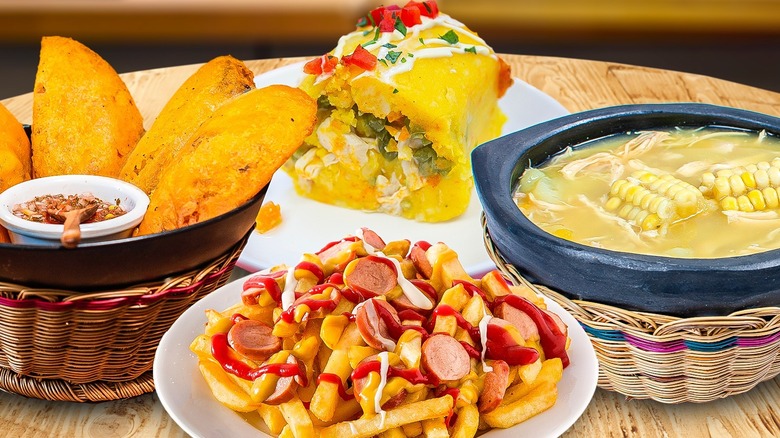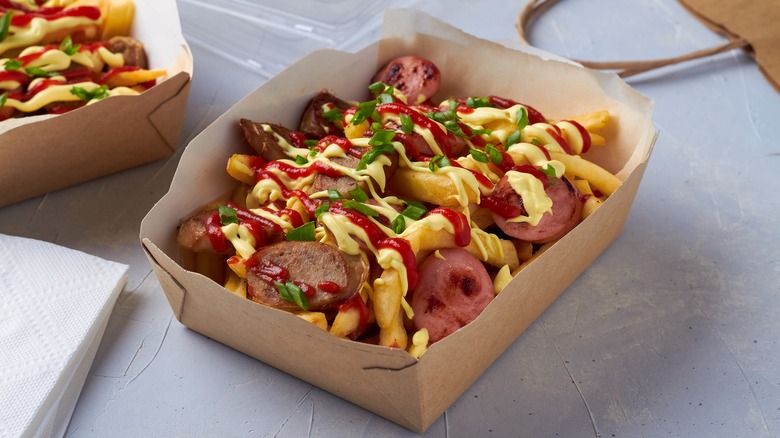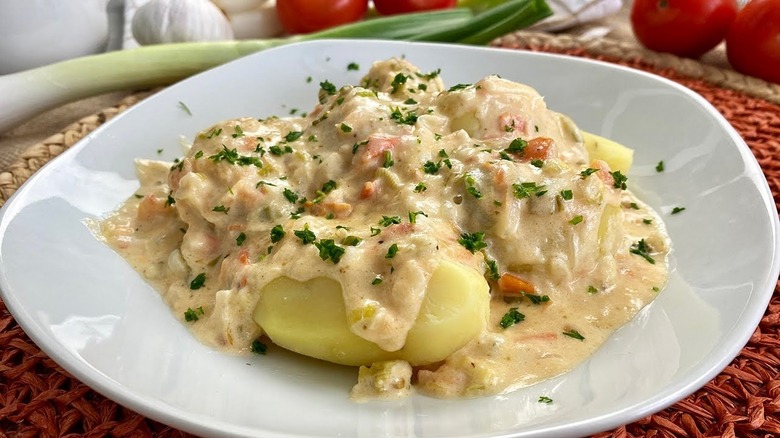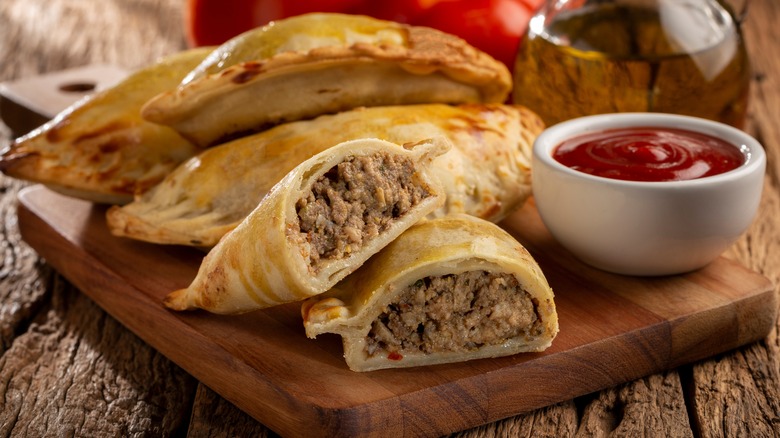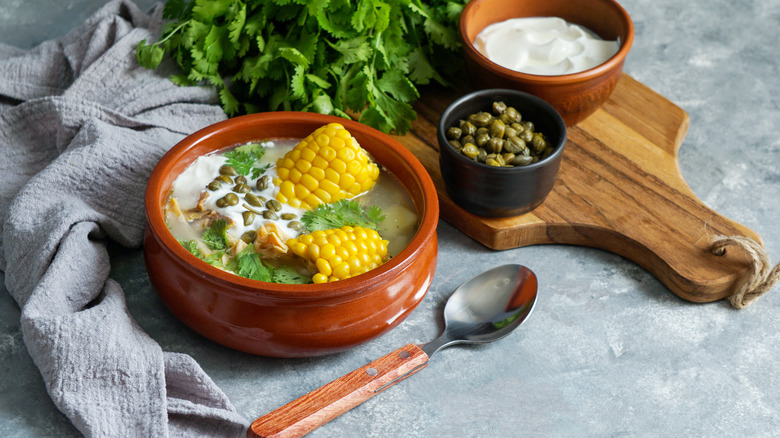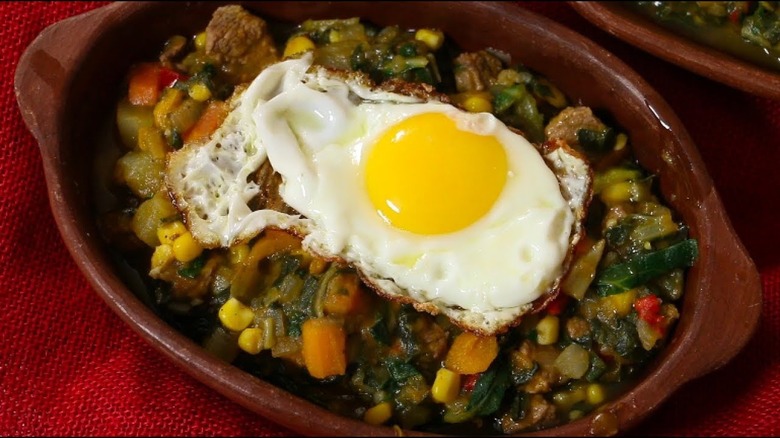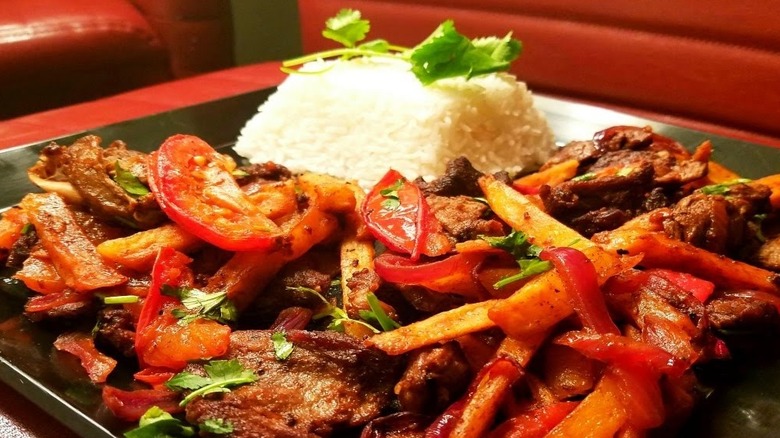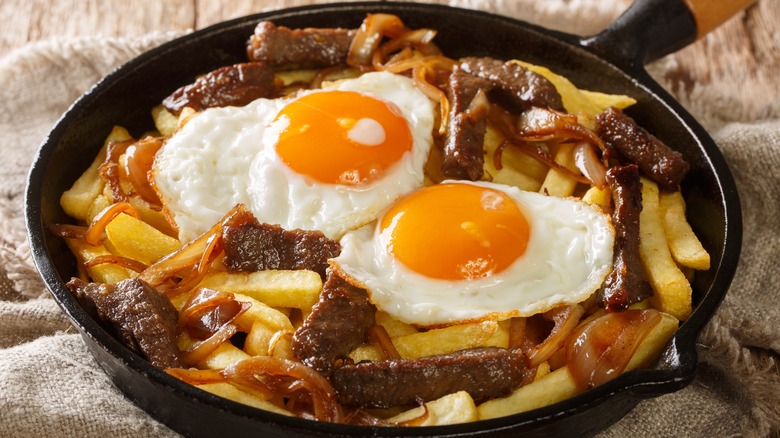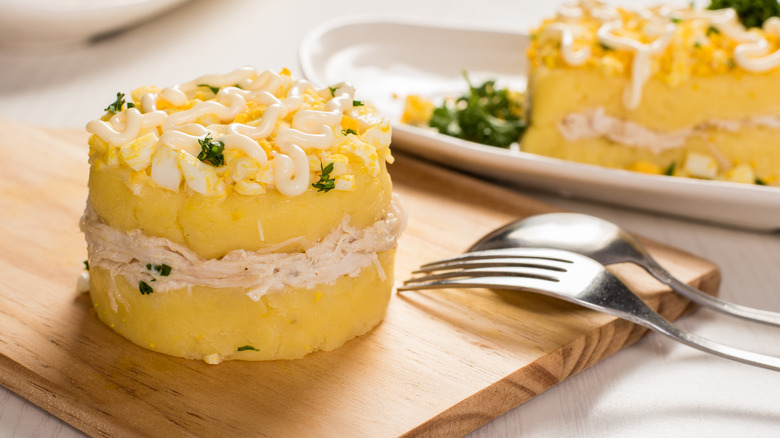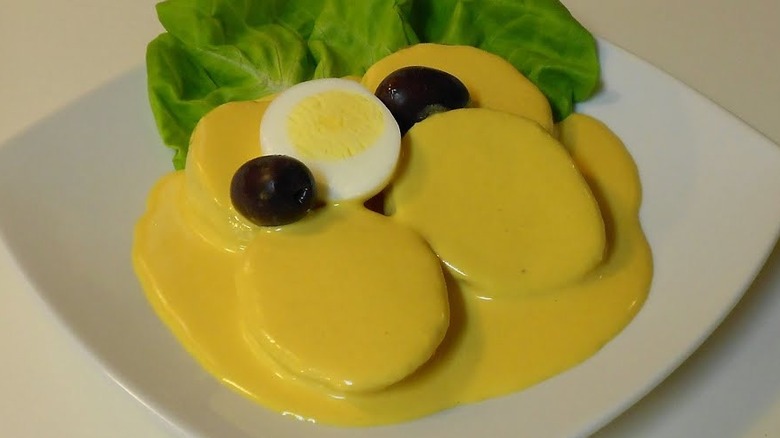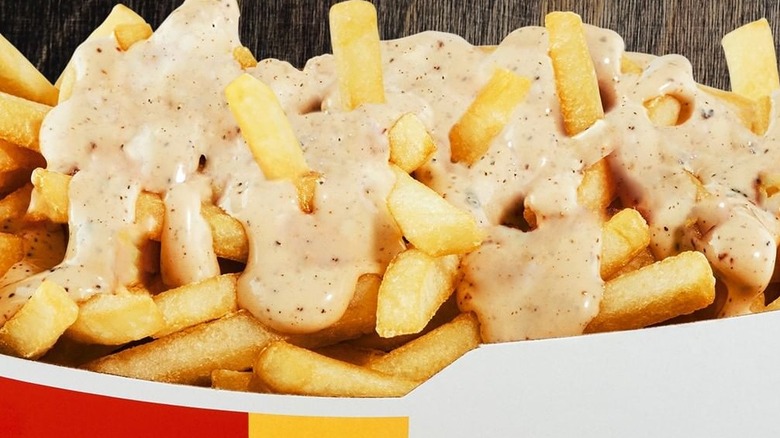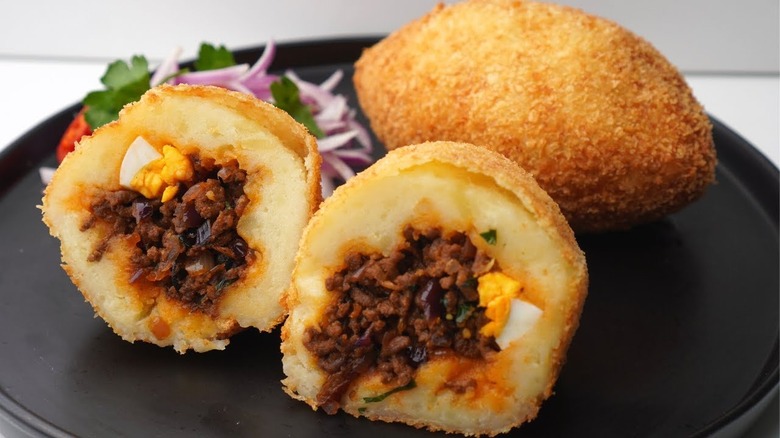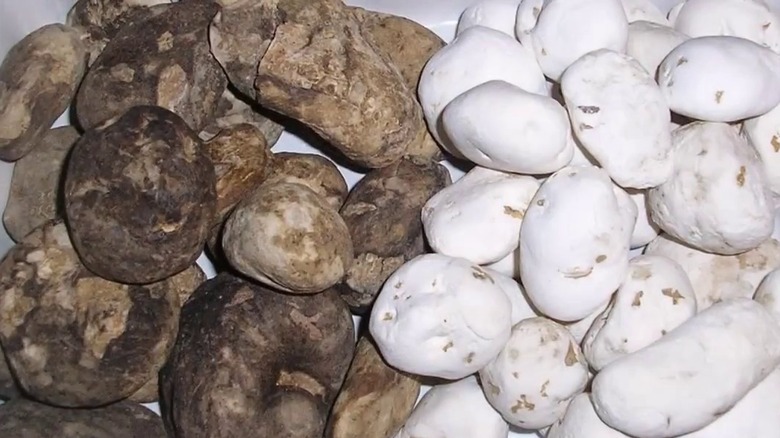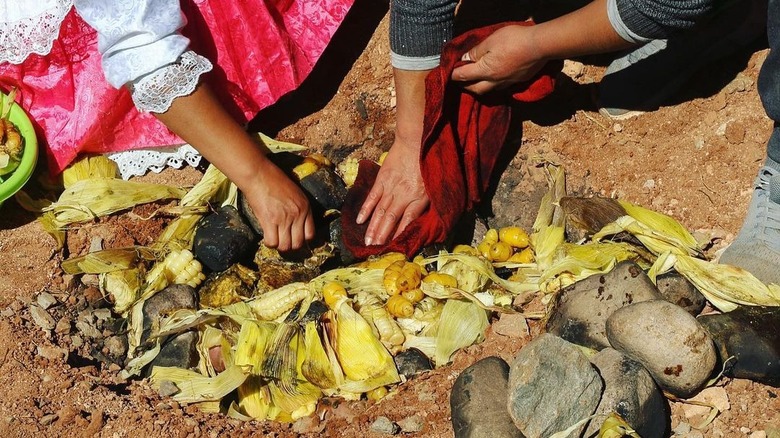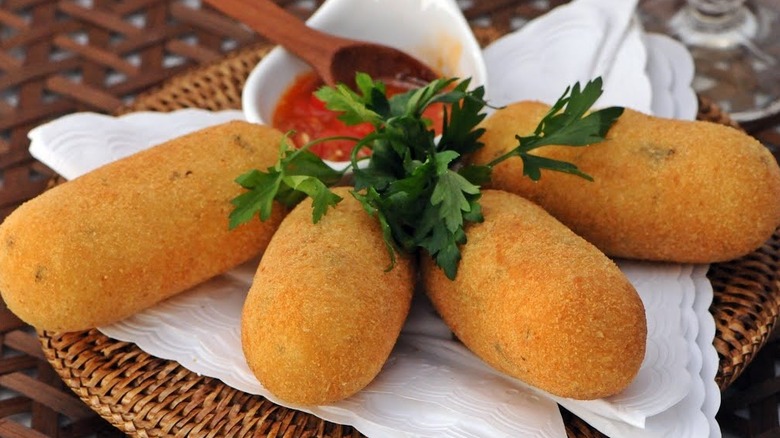14 South American Potato Dishes You Should Try At Least Once
In a world of different flavors and tastes, everyone seems to agree that potatoes are one of the best foods, period. Humble yet versatile, they are a staple ingredient used by frugal college students and Michelin-starred masters alike. Few foods compare to their customizable flavor, nutrients, availability, and affordability. Enjoyed from Idaho to India, potatoes come in many styles. Britain's hearty and filling shepherd's pie and Canada's gravy-drenched poutine count as just two entries on an impossibly long list of potato dishes worth experiencing.
While France and America etched their places in potato history, one less-highlighted hub for starchy excellence is South America. According to the BBC, potatoes were first cultivated in the South American Andes and only made it across the Atlantic millennia later, when taken by Spanish invaders in the mid-1500s. That means that history's oldest potato dishes actually originated in South America. Who could have guessed how important these tasty tubers would become?
The potato dishes found across South American cuisine are a blend of local and international influences and they're almost universally delicious. If you love chili cheese fries, you'll want to try salchipapas. If stews stir you up, a warm bowl of ajiaco should be on your list. Here are some South American potato dishes that we recommend trying at least once.
Salchipapas
Fries were born to be loaded. From savory gravy and cheese curds to the iconic mash-up of nachos and fries, toppings are a one-way ticket to flavorville. In countries around the world, you'll find many distinct styles of crave-worthy loaded fries. Take Peru, for example, where salchipapas is a popular loaded fry-style street food. It translates to "salchi" (sausage) and "papas" (potatoes) and as its name implies, includes a basket of fries topped with hot dog slices and various sauces. Believe us, those simple ingredients alone make salchipapas an instant classic.
Usually served with ketchup, mustard, and ají amarillo sauce (a spicy Peruvian condiment), salchipapas can also be customized. Barbecue is an obvious flavor-elevator, or you can really mix things up with a combo of aioli and hot sauce. Salchipapas serves as the perfect game-day substitute for plain French fries, nachos, and similar "stick-to-your-ribs" foods. In Peru, locals consider them a top street food option and vendors populate the street corners of larger cities from sun to sundown. Salchipapas are inexpensive and taste incredible. You can start from scratch or save time with frozen fries. Whichever you choose, one thing's for sure, kids will especially enjoy snarfing down this classic South American finger food.
Papas chorreadas
The Colombian dish papas chorreadas must be tried at least once. It hails from the country's melting pot cuisine, which blends Indigenous, Spanish, and West African influences. The dish is traditionally composed of red potatoes smothered in cheese (usually a white variety like queso fresco) and a creamy sauce. The sauce, called "hogao," is a chunky sofrito consisting of diced tomatoes, onions, cilantro, and garlic. The word "chorrear" means "to pour or flow," — an obvious suggestion to sauce dishes liberally. No wonder the sauce is a go-to condiment for many Colombian dishes. In addition to hogao, common ingredients include cumin, butter, coriander, and crumbled bacon bits, all of which make papas chorreadas a rich and flavorful experience.
Although popular in the colder Andean region of Colombia, papas chorreadas are an easy comfort food enjoyed throughout the country. Locals generally pair papas chorreadas with grilled chicken or steak. The potatoes can be peeled or not, depending on where you go. Beyond the home or restaurant, schools also serve papas chorreadas for lunch at school. And if you end up loving this South American potato dish, you absolutely must experience fried papas chorreadas.
Empanadas
If you grew up around Latin cuisine, you've likely tasted, or at least heard of empanadas. While different countries throughout South America put their own spin on empanadas the doughy hand pies they make in Colombia are totally distinct. Rather than wheat flour,empanadas are made with the same corn dough used for arepas. The Colombian style is simply shredded beef and potatoes paired with spicy aji amarillo sauce. After you drizzle the piquant condiment atop the crispy exterior, one bite will set off a flavor bomb.
Empanadas, one of the most enjoyed street foods in Bogotá, the country's capital, are composed of three major cultures that have influenced Colombia's cuisine. More specifically, the corn used for flour is a native crop grown by Indigenous tribes, the minced meat and potato fillings come from Creole cooking, and West Africa is responsible for passing along the deep-frying technique. Empanadas can be enjoyed as appetizers and desserts depending on the ingredients. Unlike some others featured on this list, they are widely available here in the States.
Ajiaco
Another Colombian potato dish worth trying at least once is ajiaco. Pronounced "ah-hyah-koh," it's the perfect way to experience the spirit of Colombian cuisine. This flavorful and filling soup is a simple dish that consists of potatoes, meat, and vegetables. According to Amigo Foods, ajiaco may have derived from an earlier creamy corn-based soup enjoyed by the Taíno people, an indigenous people of the Caribbean and Florida. In Spanish, "aji" means hot or chili pepper. Other South American countries enjoy ajiaco as well; ingredients sometimes vary but potatoes are a mainstay.
Peruvians cook potatoes with garlic, dried peppers, and mint, while in Colombia, three distinct potato varieties are used — criolla, sabanera, and pastusa. Chicken is the primary protein, along with guasca leaves, a common ingredient used locally that adds a subtle minty savoriness. Colombians also include avocado, cream, and capers in their version. The hearty soup was traditionally reserved for special occasions but today is eaten all day long.
Charquicán
You can't mention "Chile" and not think about food. Although far from a chili capital, the country offers a rich range of delicious dishes that feature potatoes prominently. One popular meat and potato Chilean dish you need to try is called charquicán. It's traditionally made using dried llama or horse meat, but today is most often made with ground or shredded beef. Charqui actually means "dried meat" in Spanish, and derives from the Quechuan word "ch-arki," which basically translates to "jerky." Quechua is a language tree spoken by Indigenous people from South America's Andean region per Study. Back in the refrigerator-less days, dried meat was essential to nomadic tribes, and that's how charquicán became popular.
Charquicán is a savory hash composed of meat, potatoes, legumes, and corn. From winter to summer, the ingredients used vary depending on the season. It's only supposed to be prepared using the freshest in-season vegetables — potatoes are sometimes substituted for butternut squash or pumpkin.In Chile and at Chilean restaurants throughout the world, charquicán is topped with a savory fried egg, but if you want to try the traditional style, some places still offer it with jerkied-meat.
Lomo saltado
One of the tastiest loaded fry dishes comes from Peru and is called lomo saltado, or "jumping tenderloin" in English. Lomo saltado was inspired by stir-fry, which was introduced to Peru's cultural melting pot by Chinese immigrants. More specifically, it comes from the local Chinese-Peruvian fusion cuisine called "Chifa" and is made by marinating beef strips in aji amarillo paste, soy sauce, and vinegar, then flash-stewing them with onions and tomatoes until they brown. If that doesn't get your appetite going, the marinated ingredients are tossed with French fries, with both then layered atop rice.
Although it's considered a stew, this classic Peruvian dish looks more like a stir-fry. The robust flavor will make you put the fork down and eat with your hands. Humble yet filling, it stands as a tasty testament to Peruvian cuisine. The best part about this delicious potato dish? You can easily find it at U.S.-based Peruvian restaurants.
Chorrillana
Operatic voices should sound every time a fried egg winds up lovingly placed atop a pile of fries. Another Chilean potato dish known for soaking up your pub adventures is chorrillana. Stomach-filling and munchie-pleasing, it's a simple yet effective French fry dish flavored with onions and strips of beef. In Chile, it's so popular that it even inspired a dedicated holiday called "Dia Nacional de Chorrillana." What better excuse does one need to dive into a plate of meat and potatoes than a national holiday?
Many styles of chorrilana feature different toppings. The most common are fried or scrambled eggs, sausage, or chicken — a comfort food chef's kiss. Ingredients are generally prepared separately and then paired to form a flavorful explosion. It's a dish with something for everyone, as some varieties can include different meats, seafood, and even mushrooms. Chorrilana is a large appetizer that's meant to be shared with the table, unlike other South American styles of loaded fries, which are usually made for one person. Locals serve it the only way loaded potatoes should be: accompanied by a beer or soda. You can find it throughout South America at street vendors and restaurants.
Causa de atún
Peruvian causa de atún is an eye-catching dish that's basically a mashed potato and tuna salad sandwich. The ingredients are layered similarly to a terrine, which is a French dish that utilizes several types of meat. For flavoring, potatoes are blended with aji peppers, lime juice, and parsley, giving them a herbaceous and citrusy kick. Any variety of tuna salad filling works and you can also vegan-ize the recipe by substituting it with chickpea "tuna" salad. If the taste description doesn't grab you, the presentation of the dish certainly will. It's a colorfully layered thing of Peruvian beauty and will make you anxious to take the first bite.
In Peru, chefs will sometimes alternate between different-colored potato varieties and tuna blends. Causa de atún is a versatile potato dish that can be made with ceviche, crabmeat, or smoked salmon. Veggie lovers can get in on the fun as well and use sautéed or boiled vegetables as filling. It's usually served cold and enjoyed as an appetizer or as a light afternoon lunch. Causa is also a great recipe for leftover mashed potatoes.
Papa a la huancaína
A Peruvian food staple, papa a la huancaína is a cold dish that will warm up your soul. Known in English as "Huancayo-Style Potatoes," the name comes from Huancayo, Peru, a region linked by transit to Lima, where the dish was invented. According to Amingo Foods, upon the railway's completion in the late 19th century, workers who grew to love papa a la huancaína gave it its name. This dish is traditionally served as an appetizer that consists of boiled potatoes atop a bed of lettuce that's liberally smothered with a spicy and creamy cheese sauce. It also includes black olives and sliced hard-boiled eggs, making it a protein and carb-rich treat.
The sauce itself is made with aji amarillo, queso blanco (or fresco), oil, saltine crackers, and evaporated milk. A simple and versatile condiment, it also works aa a mean dip, pasta sauce, or risotto. We recommend enjoying it for a midday lunch. After you take a bite, you'll understand why kids and adults alike love the Peruvian classic.
Peru's loaded McDonald's fries
Getting to experience the offerings of popular fast-food franchises in other countries ranks as one of the great pleasures of traveling. A symbol of American-style fast food, the well-oiled and fine-tuned touch of McDonald's reaches every corner of the globe. While iconic menu items like the classic fry and Big Mac are generally available everywhere, McDonald's international menu features everything from the fruit jam-topped Big Rösti Cranberry from Germany to South Korea's meaty Double Bulgogi Burger. And, those barely scratch the surface of what ends up in McDonald's branded wrapping paper.
Peru's McDonald's has loaded fries on the menu. In Peru, McDonald's elevates its iconic fry into something truly mmm-inducing. Imagine biting into a crispy golden crunch doused with a savory sauce. Fun Fact: The sauce is the same used on the now-discontinued Big N' Tasty burger that was popular through the late 90s and early 00s, which is seasoned with black pepper, onion powder, and natural smoke. To top it off, a version with delicious bacon bits is now available. McDonald's loaded fries are also available in Argentina.
Papa rellana
If Peruvian cuisine shines at anything, it's coaxing the flavorful possibilities out of potatoes. Papa rellena (pronounced rayl-ena) is another iconic dish that deserves a spot on your culinary bucket list. Known as Peruvian stuffed potatoes, this deep-fried treat is actually popular throughout South America, where it's sold by street vendors, as well as restaurants, and cooked at home. Papa rellena translates to "stuffed potato," an apt name for a dish composed of deep-fried mashed potato balls filled with spiced beef. It's easy to picture yourself devouring a whole plate of these bite-sized, crispy, and moist treats.
Similar to a potato croquette, the filling can vary and commonly includes raisins, olives, and chopped hard-boiled eggs. You can make a meatless version if you're vegetarian or vegan too. Like many Peruvian potato dishes, papa rellena gets its spice from aji amarillo peppers, and it can be enjoyed as an entree, hot or at room temperature, and for any meal of the day.
Chuño
South American potato dishes came before the geniuses in Belgium invented the famous fried variety. Chuño is quite possibly the most unique potato dish invented in South America. Unlike the aforementioned styles, it's a staple food from the Incan era that's freeze-dried naturally. Although the Incan Empire existed back in 1438 (per Britannica), the freeze-drying technique they used worked as well as today's machines, some of which cost upwards of $1,000. Freeze-drying was achieved thanks to the region's cold environment along the Andes mountain range.
Chuño is made by spreading a single layer of small potatoes on the ground. According to France 24, farmers will sometimes freeze-dry thousands of tubers at a time, with the potatoes usually left overnight for three days and dried by sunlight. Following the third day, the remaining moisture is stomped out by foot, similar to the making of wine. Next, the potatoes spend two additional weeks in the field, where they undergo a "mummification" process. Freeze-drying makes chuño bacteria- and mold-resistant, and able to last for years with proper storage. Taste-wise, chuno is more of a novelty delicacy worth trying purely to experience ancient foods. It's actually been compared to chalk or styrofoam. While less available today, chuño can still be found in parts of the South American Andes region.
Pachamanca
Cooking techniques from yesteryear are still employed in Peru. One time-tested ticket to deliciousness is earthen ovens. According to the Minnesota Conservation Volunteer, evidence shows that people have been using them for thousands of years. In Peru, the pachamanca celebration keeps the tradition going. It's a yearly festival that celebrates Pachamama, the Incan Mother Earth goddess and pays respect by cooking food in earthen ovens. Pachamanca actually translates to "earth oven" in the Quechuan language. For the celebration, locals prepare food in rock-filled pits that are buried in the ground, per Rainforest Cruises.
Pits are lined with bricks and heated volcanic stones, which can withstand high-intensity temperatures. Food is then layered into the pit using damp banana and chincho (Peruvian herb) leaves that help produce steam which cooks the food evenly. A pachamanca feast consists of a laundry list of tasty options. Starchy ingredients like sweet and regular potatoes enter first, along with cassava. Next up are meats like seasoned lamb, chicken, alpaca, and pork, while corn on the cob, lima beans, chilis, carrots, and fava beans continue the hunger pangs. The final cherry on top is humitas, a creamy cinnamon-flavored tamale. Pachamanca feasts are generally home-cooked affairs. While some restaurants offer it, only a tour through Peru or a Peruvian family can deliver a truly authentic experience.
Bolinho de bacalhau
Peru is not the only South American country known for bite-sized potato dishes. Brazil's version of a hush puppy might have America's Cajun-style beat in the delicious department. Called bolinho de bacalhau, which translates to "fried ball of cod," it's a traditional Portuguese appetizer dish that can be enjoyed as a main course as well. In Brazil, this tasty finger food is usually sold at Portuguese restaurants but can also be found at street fairs, family get-togethers, and parties. A quick and easy on-the-go snack, bolinho de bacalhau is garnished with fresh herbs and comes with a dipping sauce and beverage when served.
It has a crispy exterior and a deliciously moist interior. If you're looking to reduce your fried food intake, though, a side salad helps to turn this appetizer into a balanced meal. When it comes to recommendations, bolinho de bacalhau is definitely a Brazilian dish you need to try at least once.
